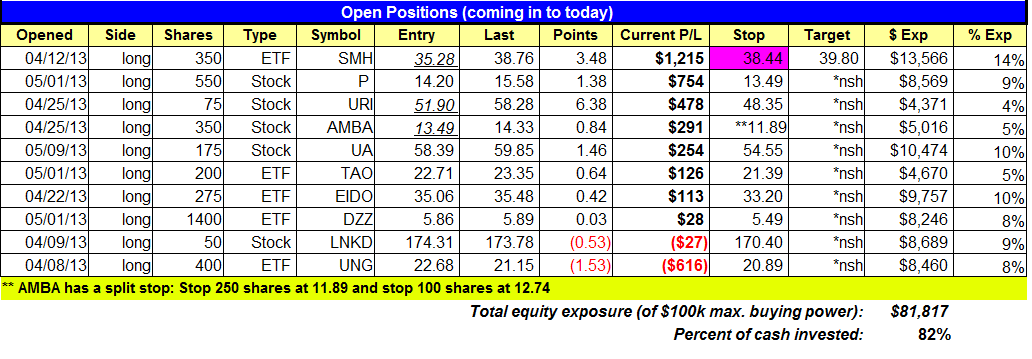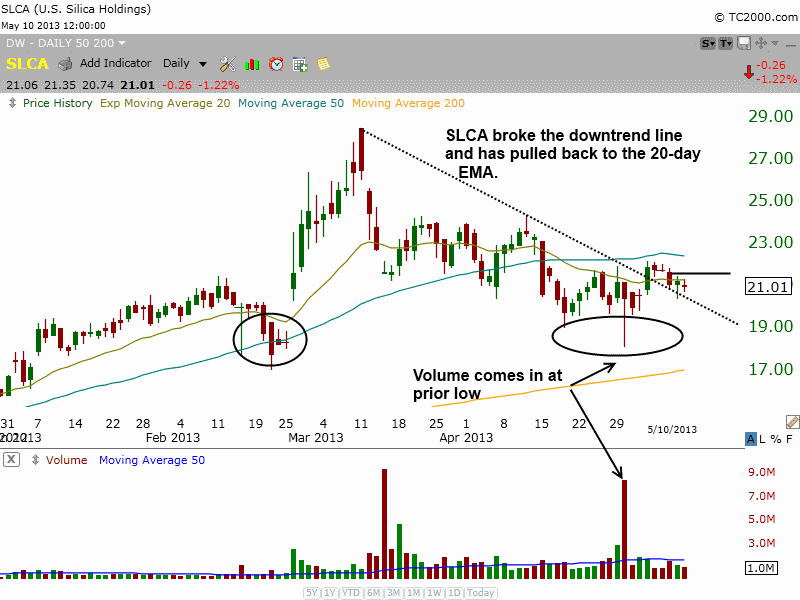Buy
– Signal generated on the close of April 30 (click here for more details)
today’s watchlist (potential trade entries):

Having trouble seeing the open positions graphic above? Click here to view it directly on your web browser instead.
open positions:
Below is an overview of all open positions, as well as a report on all positions that were closed only since the previous day’s newsletter. Net P/L figures are based a $100,000 model portfolio. Changes to open positions since the previous report are listed in pink shaded cells below. Be sure to read the Wagner Daily subscriber guide for important, automatic rules on trade entries and exits.

Having trouble seeing the open positions graphic above? Click here to view it directly on your web browser instead
closed positions:

Having trouble seeing the closed positions graphic above? Click here to view it directly on your web browser instead.
ETF position notes:
- No trades were made.
stock position notes:
- No trades were made.
ETF, stock, and broad market commentary:
Stocks continued their resilient advance last Friday, as the Nasdaq Composite jumped 0.8%. The Dow Jones Industrial Average and S&P 500 indices lagged behind with gains of 0.2% and 0.4%, but that has been the norm since leadership has been rotating into the Nasdaq since this current rally off the mid-April lows began. The broad-based gains enabled the S&P 500, Dow Jones Industrials, small-cap Russell 2000, and S&P Midcap 400 indices to set fresh all-time closing highs (again). The Nasdaq finished at its highest level since late 2000.
Turnover eased across the board last Friday, but higher volume gains (“accumulation days”) are of less significance when the major averages are trading at record highs. In the current situation, we are much more concerned about the presence of higher volume declines (“distribution days”), which would point to institutional selling.
In the May 10 issue of The Wagner Daily, we pointed out the bearish “shooting star” candlestick pattern PowerShares QQQ Trust ($QQQ), a popular ETF that tracks the Nasdaq 100 Index, formed on May 9. We then said the formation of such a pattern is often a warning sign to the bulls that stocks may be running out of gas in the near-term. Although the broad market followed up with a solid day of gains in the following session, the signal is still valid because $QQQ failed to close above the intraday high of the May 9 session that formed a “shooting star:”

As we frequently remind subscribers, the most important technical indicator at our disposal is simply price action. Therefore, as long as bullish momentum remains, we must continue to take advantage of the strength by holding long positions. A mere one-day signal like the “shooting star” is never more important than the actual price action in the market. Nevertheless, we remain prepared for the substantial possibility of at least a short-term correction in the coming week.
On the “open positions” section of today’s report, notice that we have, for the fourth consecutive day, trailed our protective stop higher in Market Vectors Semiconductors ETF ($SMH). Because the ETF is already nearing our original target area of $40 while remaining on a very steep angled climb, we are continually squeezing the stop tighter in order to protect gains, while still allowing for maximum profit.
On the daily chart of $SMH below, we have labeled the increasingly higher stop prices we have used in each of the past four sessions:

As you can see, our stop in each of the past four sessions has been raised to just below the low of the prior day’s session. Whenever an ETF or stock is nearing your target area and you wish to maximize profits while still protecting gains, setting a stop just below the previous day’s low (allowing for a tiny bit of “wiggle room”) is a great strategy. This is because basic technical analysis states the prior day’s lows and highs act as very near-term support and resistance (respectively).
By using this method for trailing stops, you will be out of a winning position before the start of a significant pullback, while still allowing the gains to build as long as buying momentum remains. This system also provides an objective way for knowing when to close a winning swing trade, rather than guessing and potentially leaving significant profits on the table.
Last week, we pointed out the “cup and handle” type pattern that was forming on the daily chart of Guggenheim Solar ETF ($TAN). We expected the handle (consolidation) to build for another week or two, but the ETF convincingly broke out above the range last Friday instead. Furthermore, the breakout was confirmed by a spike to more than 2x the average daily volume of $TAN:

Although we missed last Friday’s breakout, this trade setup could still provide us with a low-risk, secondary entry point if the price pulls back to near the breakout level on Monday. As such, we have added $TAN to our watchlist as a potential buy entry.. Note the $TAN trigger price is a BUY LIMIT order, which means we will only buy IF it pulls back to our predefined buy limit price.
We have one new setup on the watchlist in $SLCA. The chart below shows the downtrend line break after a big volume, reversal candle on 4/30.

The past two days, $SLCA has tested the “backside” of the downtrend line and held (the backside of the downtrend line occurs when a stock breaks above a downtrend line and pulls back to that line). If $SLCA can clear the two-day high it will be back above the 20-day EMA as well. The stop is pretty tight, as we want to be right or right out, so we are taking small size. If $SLCA can reclaim the 50-day MA on heavy volume this week, then we may look to add to the position, or wait for a short-term consolidation to develop above 24.00.
$LNKD washed out a few stops on Friday, but may need to go lower before it can resume its uptrend. Our stop remains the same.
$P followed through to the upside last week and is in good shape. There may be a bit of resistance at $16, but if it can clear this level then the $19-$20 area is the next stop.
relative strength combo watchlist:
Our Relative Strength Combo Watchlist makes it easy for subscribers to import data into their own scanning software, such as Tradestation, Interactive Brokers, and TC2000. This list is comprised of the strongest stocks (technically and fundamentally) in the market over the past six to 12 months. The scan is updated every Sunday, and this week’s RS Combo Watchlist can be downloaded by logging in to the Members Area of our web site.